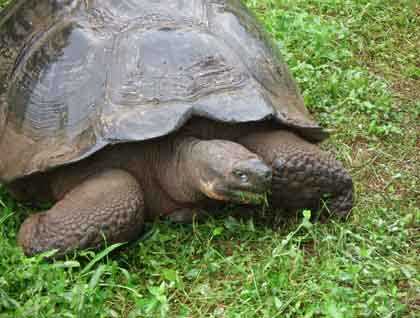After a fortnight’s navigation, the National Geographic Islander anchors at Academy Bay, a busy bay with small launches, cargo ships, motor yachts, and fishing boats. The bay gives access to Puerto Ayora, the largest town in the archipelago. This town is almost visibly growing on a daily basis, and today we get the chance to see that.
After breakfast we head out for the tortoise breeding center, where we learn and see how tortoises of different subspecies are raised from an egg to a sturdy juvenile. We see as well the difference between a dome-shaped tortoise and a saddleback, or Galapagos, tortoise. Next to the breeding center stand some of the buildings of the Darwin Foundation, where we admire the pretty native gardens.
After our visit to the tortoises we have some time to explore town. Puerto Ayora is a boomtown, and has visible problems with unrestricted growth and speculation. The waterfront is occupied by private and public buildings, blocking the view of the bay. We marvel at the mishmash of buildings and street furniture, and some enjoy an unforgettable scene involving sea lions, pelicans, and humans at the fishermen’s dock.
After lunch in the hills of this island we head out into the meadows of a private farm, where we once more see giant tortoises, this time more active, mostly eating grass. It is a great opportunity to see how they filled in the ecological niche of a large herbivore on these islands. A light drizzle making the air slightly colder explains the size of the animals - to stay warm enough these reptiles needed bulk, and thus became the world’s largest tortoises.
Knowing that the first turtles roamed the earth some 200 million years ago, and have gone virtually unchanged since then, gives some of us the wonderful sensation that we witness a scene that could have taken place in the Pleistocene or earlier, given that the vegetation on Santa Cruz is partly endemic or native.
During the walk we also enter a lava tube, a subterranean tunnel carved out by hot lava during the formation of this island. Only recently speleologists have discovered such a tunnel on Santa Cruz that turns out to be the largest in Latin America!
Once we head back to the National Geographic Islander’s dock site, some of us opt for a walk into town, now a busy and bustling place with people from all over the world. On the main square the playground is busy with some of the many young children that live in this unique place, while next to them their fathers play endless games of volleyball.







